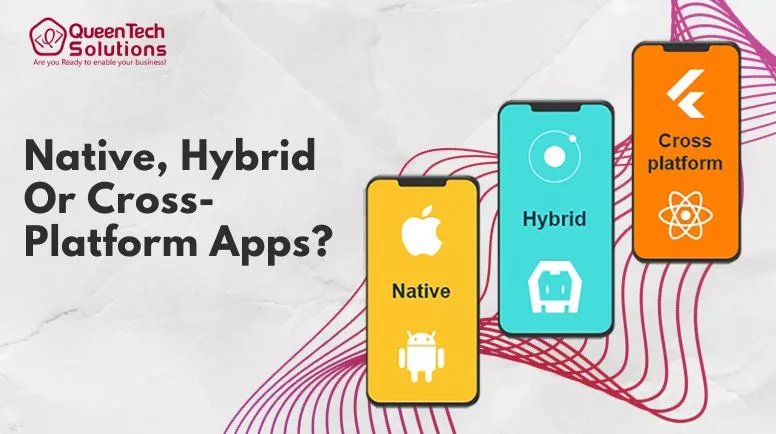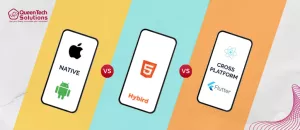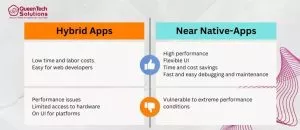- December 3, 2023
- Posted by: Jacky Melek
- Categories: Software Development, Mobile App Development, UI/UX App Design

As long as there’s no clear winner in the platform competition when ask what is the difference between native app and hybrid app, mobile app developers will likely continue to avoid committing solely to Android or iOS development. The allure of reaching a broader audience remains strong, and the existence of cross-platform app development tools facilitates a quicker and more efficient delivery of apps to Android, iOS, and even less mainstream platforms.
Many app developers who specialize in one platform might have doubts about the technology behind cross-platform apps. To provide some insight, our mobile developers recommend carefully examining the advantages and disadvantages of cross-platform mobile development compared to native development.
What Is The Difference Between Native App and Hybrid App Or Cross-Platform
The confusion often starts with the terms “cross-platform” and “hybrid,” which are sometimes used interchangeably. However, they represent distinct concepts within the mobile app development domain.
Cross-platform development is a broad term covering projects targeting multiple platforms. On the other hand, hybrid development is a subtype with a specific approach. Tools like Cordova and PhoneGap are examples of hybrid development, allowing the creation of apps that blend web and native elements. Developers write the code in HTML, CSS, or JavaScript, and it’s later wrapped in an invisible native WebView browser.
There’s another category of cross-platform development tools that don’t use WebView and directly communicate with the platform. Although they fall under the general cross-platform term, they’re occasionally referred to as native development tools, adding to the confusion. For simplicity, we’ll call them ‘near-native’ tools here and explore why they earn such recognition.

The Pros of Cross-Platform Mobile Development
Hybrid
Hybrid apps offer a significant advantage in terms of speedy development. Even developers who are relatively new to the field mention that they can create and complete an app in just a few days. Faster development naturally translates to lower costs.
Web developers, in particular, enjoy the perk of leveraging their existing skills without the need for additional learning or experience in app development. Their proficiency in frontend development allows them to seamlessly transition into creating mobile apps without stepping out of their expertise.
Near-native
The term ‘near-native’ for these tools isn’t arbitrary; it underscores their comprehensive nativity. Apps developed using frameworks like React Native or Xamarin are treated as native at the code level. In contrast to hybrid apps confined to WebView, they enjoy direct access to mobile hardware. These apps exhibit minimal performance limitations, showcasing agility in both video and audio processing, making them well-suited for intricate mobile applications.
The efficiency of this cross-platform development approach lies in the shared fundamental app logic. Regardless of the number of platforms targeted, developers only need to create the core of the app once. Subsequently, they can fine-tune functional and visual specifics for each platform separately. This not only expedites the development process but also makes debugging and maintenance faster and more straightforward.
Another notable advantage is the flexibility in UI/UX development. In Xamarin, for example, developers can choose between a basic, consistent interface created with Xamarin.Forms or a customized interface tailored to each platform in Xamarin.Android and Xamarin.iOS, ensuring a 100% native look and feel.
Hybrid
In contrast to native and near-native tools, those used for hybrid development cannot ensure flawless performance. The reliance on WebView, essentially a browser, keeps it separated from the device’s hardware for safety reasons, just like a typical web browser. Hybrid apps need special plugins to access features like GPS, camera, or accelerometer, causing significant hindrances to both speed and security.
Apart from performance limitations, hybrid development provides only a standardized interface for all platforms. Despite its uniformity, the UI of hybrid apps can still be visually appealing when built on a suitable framework. For instance, Ionic offers a variety of material-design templates and kits, enabling developers to craft a stylish design without the need for UI/UX experts.
Near-native
Despite the impressive performance of near-native apps, they still fall short of being entirely native. Pinpointing the exact functional limit of this cross-platform development option is challenging, but it does exist, unlike in native apps, which don’t face such constraints.

Conclusion
Our offshore software development company understanding the distinction between hybrid and ‘near-native’ cross-platform development tools is crucial for identifying their optimal use cases. Each tool serves a specific purpose, benefiting projects in different ways. Cordova, for instance, excels in skill reuse and rapid development, while other tools may be best suited for projects aiming to maintain a single core platform version instead of three.
Rigidly adhering to native development alone and dismissing other possibilities isn’t practical. Making an informed decision requires a thorough understanding of the future app’s capabilities and an impartial assessment of what each development tool brings to the table.
Call us today to know the cost of maobile app development and leverage our comprehensive expertise, cutting-edge latest models, and consultancy services to help you achieve your business goals through QTS software company in Egypt.
Check our related artical about cross-platfrom for healthcare mobile app developement.




